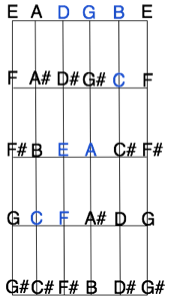the c major scale
Learning music without learning scales is equivalent to trying to learn the English language without learning the alphabet. They will work magic on your technique, in that you’ll gain strength, speed, agility and confidence in your fingers. This will result in much greater clarity and musicality in your playing. In addition to this the musical benefits are enormous. Chords, melodies, and songs all come from scales. They are the core of the language of music, and as such they are the foundation for all of the music you’ve ever heard. Our goal in this lesson is to gain a basic understanding of, and to learn how to play a C Major Scale.
First, let’s meet a new friend, the Chromatic Scale. We’ll then use it to locate some notes on the neck. The Chromatic Scale is as follows:
A - A Sharp - B - C - C Sharp - D - D Sharp - E - F - F Sharp - G - G Sharp
Notice that there is a sharp in between every letter except E and B (remember Everything But). Also, the above is the last time we’ll be using the word “sharp”. From now on, we’re going to use the "#" symbol. Here then is the updated Chromatic Scale:
A A# B C C# D D# E F F# G G#
These are all of the notes in our world. They are the same on your guitar, a piano, a clarinet, or anything else. There are twelve notes in existence, and they repeat into infinity in that order. Memorize this pattern, as your understanding of everything we’ll talk about going forward depends on it.
Now we’re going to find a few notes on your guitar. Begin by plucking the open fifth string (the second fattest, and second from your head). The name of that note is A, which is why it’s called the A String. Say “A” to yourself. Now place the first finger of your fretting hand on the first fret of the same string, and pick it. Now you're playing A#. Say "A#" out loud. Next, slide your finger up one more fret and say "B", because that's exactly what you're playing. Please refer now to the note names I underlined above. Do you see what's happening? By moving up fret by fret you are playing all twelve notes in order. Keep going and saying the names! When you reach the 12th fret you are back at A, having traveled one octave, which is the distance from any note to the next note with the same name. Try this on each string, remembering to begin from the letter corresponding to the name of the string. For example, if you’re on the E string, begin from E. E is open, followed by F on the first fret, F# on the second, G on the third and so on.
Now we’re going to assemble a Major Scale. This is not a difficult task, but first we need to define two new terms, Whole-Step and Half-Step. A Whole-Step is what occurs when you skip one note, and a Half-Step is when you proceed to the next adjacent note. For example, the distance between C and D is a Whole-Step, because you skipped over C#. From B to C is only a Half-Step, because there is no B#. From now on, we’ll be using the letter “W” to indicate a Whole-Step, and the letter “H” will represent a Half-Step.
Bearing all of this in mind, let's build a C Major Scale. We will use the following formula: Root-W-W-H-W-W-W-H. It is hugely important that you memorize this formula. Since we are building a C Major Scale, we will choose C as the Root note. From C we go up a Whole-Step to D, another Whole-Step to E, a Half-Step to F, a Whole-Step to G, a Whole-Step to A, a Whole-Step to B, and the final Half-Step returns us to C, the point of origin. Here’s another way of looking at it:

Notice there are no #'s. C is the only major scale we can say this for. All of the others will contain Sharps, or Flats (which from now on will be referred to by the "b" symbol). We're not dealing with b's at this point so you won’t be seeing any of those. Here is a diagram displaying the locations where the notes are to be played. The notes in the scale are blue.

To play it, follow the dots in the diagram below, simply starting at the dot with the "1" next to it, and continue playing one at a time until you reach number "8". Once you’re there, turn around and go in the opposite direction. Nothing in this diagram is telling you which finger to use, so what you do is match the finger with whatever fret you're on. First fret = first finger, second fret = second finger, third fret = third finger. Do not play the scale with one finger, as that will not do anything to build your technique.

Here is a demonstration video. As you’re playing the scale, try naming each note as you go. C D E F G A B C, then in reverse.
Regarding practice at this point, you should be shooting for 15 minutes of the material covered in the first four lessons. Try warming up with the finger exercise, then working on your chords and the C Major Scale in whatever order you prefer. The idea is to practice these things until they are embedded in your DNA. Equally important is that your “serious” practice time is followed by plenty of time “playing” your guitar. I know that you have only learned two chords and one scale, but you’d be amazed at how far that can go! At every stage it’s important to use the tools you have at your disposal to experiment with, because that’s how music is made. This is how your musical personality will begin to take shape.
